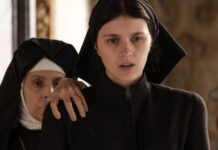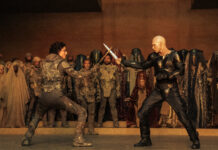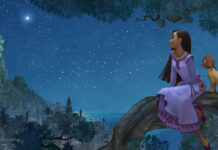This post contains affiliate links and our team will be compensated if you make a purchase after clicking on the links.
Thus far in the year of 2011, movie theaters have been awash in their share of prequels, sequels, and even the occasional fourquel. A mere few have delivered, while most by now have come and gone as embarrassments to their respective franchises. So when seeing the seemingly nonchalant trailer for a new “Winnie the Pooh,” it would be easy to dismiss it as just another reboot. The story of a stuffed bear and his cotton-filled companions has been told and retold for nearly a century. In a day and age when children’s attentions are glued to films populated by life-like CGI characters and environments, one has to wonder what has prompted the creators at Disney to go back to the basics. It is indeed the basics, and beautiful they are, that are the very reason for this delightful return to the Hundred Acre Wood.
“Winnie the Pooh” is a success on almost every level due to its perfect balance between both the new and the familiar. From the very first frame, the film ushers the audience in with a great rush of nostalgia, as we get our first glimpse of Christopher Robin’s room. For anyone who has ever read a Pooh adventure or seen one of the films, it is as if you are coming back home. Everything is there just as we left it. The stuffed bear, the donkey, the rabbit, kangaroos, owl, and of course, that peculiar tiger. In no time, we find ourselves caught within the pages of A.A. Milne’s book, with a calming narrator as our guide.
This adventure is not unlike previous ones. Pooh is looking for honey, Piglet is afraid, and Eeyore is gloomier than ever. The story takes place in the timespan of one day, but that one day is all these characters need to experience a multitude of new sights and a few frights. Early on in his search for honey, Pooh notices that Eeyore’s tail has gone missing, and must soon choose whether his growling tummy or his friend is a higher priority. Good ‘ol Owl in all his misinformed wisdom quickly creates a contest in which the entire gang try to help find a new tail for poor Eeyore. As with all good Pooh adventures, things soon grow out of proportion, and he and his friends must overcome more than just their own collective silliness.
Halfway through the film when Christopher Robin disappears for a time, Owl claims that their beloved human has been captured by a terrible monster known as the “Backson.” The drama that follows is full of original humor, but even more impressive is the manner by which the animals’ fears come to the surface and teach more than one valuable lesson. This underlying tone of classic morality is the backbone of the entire story. The writers of the film highlight the characters’ vulnerabilities rather than their strengths, thus giving the adventure a surprising measure of maturity that even adults will find hard not to appreciate.
The true brilliance of “Winnie the Pooh” is due in fact to how quietly unassuming it is. The story refuses to follow any type of well-exhausted formula. Instead, it devotes time to focus on the individual journeys of the characters. Owl, Eeyore, and Pooh are highlighted extensively – one eccentric, one depressed, and the other a little bit selfish. Each new turn in the adventure comes as a breath of fresh air, usually unexpected, and never tying to push the envelope or over-impress the audience. In keeping with the minimalism of the story, the run time of “Winnie the Pooh” clocks in at a mere 70 minutes, but this is the perfect kind of movie that doesn’t require any more or any less.
The movie’s expert storytelling is mirrored in every way by the visual elements. It has been thirty-five years since the last Pooh film was animated within the walls of Walt Disney Studios, and this is surely one of their finest works to date. It is impossible to ignore the unfaltering commitment to hand-drawn animation that is evident in each and every frame. The swatches of color, pencil lines, and brush strokes inhabiting both the backgrounds and foregrounds are all individually unique. It is truly the artistic imperfections that give the faces and places of the Hundred Acre Wood such depth and character. There is also the delightful use of the physical book as the characters jump and interact frequently with the letters and paragraphs of the narrator. It’s as if the animators have melded literature to film, and the results are joyously wonderful.
While the imperfections in the art tend to enhance, imperfections in the voice acting only causes the movie to suffer. “Winnie the Pooh” features mostly new actors taking on the challenge of interpreting the voices of extremely familiar characters. Craig Ferguson (“Late Late Show”) is unmistakable as Owl, reinventing the character from the voice up. Newcomer Jack Boulter is another welcome addition as Christopher Robin, creating a voice that is as silky smooth as it is fatherly. But as for the rest of the vocal talent, there is an obvious disconnect between the voices and characters. It is as if they belong in a standard 3d animation, not such a classic as “Winnie the Pooh.” But this is a minor qualm, and is easily compensated by the dreamy addition of multi-talented actor and musician Zooey Deschanel. Her singing practically floats along in the re-imagining of the theme song and continues to set a dreamlike tone in the music for the entire film.
This “Winnie the Pooh” is another memorable chapter in a timeless tale, as it succeeds in doing something that few other children’s films these days are capable of: capturing the joy that is found in the innocence of imagination. These characters were never designed just for children, but for, as the great Walt Disney once put it, “the child in all of us.” The film takes the peculiarities and enduring traits of the characters that have always been, and molds them into something newer and much better. Just like a great legend, the tales of “Winnie the Pooh” have never stopped growing, while retaining the simplistic life truths that makes them unique. Revived for another generation of any and every age, this adventure is sweeter than ever – just how Pooh would like it.
Discover more from Socalthrills.com
Subscribe to get the latest posts sent to your email.











